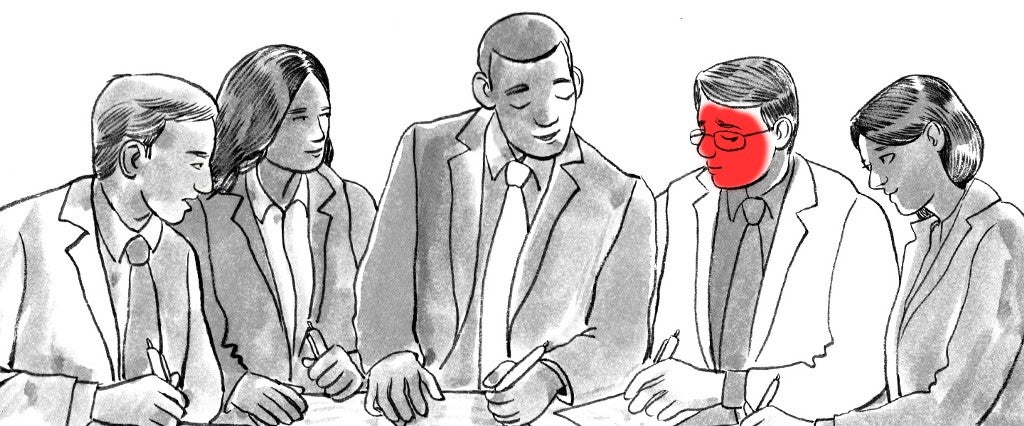“I sometimes think I should wear a badge that says, ‘Please do not expect sparkling conversation.’”
Joe Moran is smiling as he says this, but he isn’t joking. Being shy, he says, feels like “you’ve wandered into life halfway through and everyone got told the rules before you turned up.”
Moran, a social historian and professor of English and cultural history at Liverpool John Moores University in the U.K., Moran is speaking at London’s Southbank Centre as part of the annual Being a Man festival, an exploration of 21st-century masculine identity. His subject, shyness, seems to have struck a particular chord.
Business analyst Matt Maude, 32, emailed me after he heard I was writing about shyness: “I find small talk very difficult, never knowing what to say or what is expected of me,” Maude said. “While I’m trying to work out what to say the conversation ends or moves on without me. Those I am with perceive that I’m not interested in speaking to them or that I’m stupid and have nothing to say. I get embarrassed, become red in the face, and find it harder to clear my head enough to talk. If the situation becomes particularly severe I develop a lisp. I don’t even have a trace of a lisp normally!”
Shyness, Moran explains in his new book Shrinking Violets: The Secret Life of Shyness, is often due to people overthinking social interactions, a view shared by famously diffident Peanuts cartoon creator Charles Schulz. “I think shyness is an illusion” he told publisher and critic Gary Groth in 1997. “Thinking you’re the only person in the world. It’s just being overly self-conscious.”
Of course, that’s not very helpful to the dudes actually experiencing that chest-constricting, brain-clouding sense of frustration and social paralysis. Especially when it appears at odds with their masculinity.
“There is a long history in Western cultures of cultivating shyness as something women should be good at, basically to stop them speaking in public. It’s seen as a positive trait in women,” Moran says. “The flip side is that it’s seen as unmanly.”
For a woman, even aloofness comes with a weird sort of kudos. Men, however, are expected to be confident and assertive; failure to display these traits results in social rejection, something every man I heard from had felt.
“I think shy men get overlooked, or assumed not to be passionate or driven,” said IT business owner James Eades. “I have also experienced business dinners where I don’t manage to put my views across because I’m the shy one in a group of very dominant business leaders.”
Maude was more direct. “In my experience there is no sympathy or understanding displayed to men in this situation,” he said. “The prevailing attitude seems to be that shyness is not manly and if you suffer from it you are less than a man and worthy of contempt.”
This hasn’t always been the case. As Moran discusses in his book, shyness used to carry a certain distinction, for both men and women — not least on his side of the Atlantic, where shyness often manifested as the famous British reserve. English playwright Alan Bennett, born in 1934, often spoke of his mother’s belief that shyness stood for sensitivity and refinement. “It was a sign that you weren’t vulgar or common, putting yourself forward and being brash and bolshy,” Moran explains.
It wasn’t until the mid-20th century that a shift occurred, initiated not by Moran’s fellow Englishmen but by American psychologists. Albert Ellis, known as the grandfather of cognitive behavioral therapy, grew up shy and tried to overcome it by challenging himself to talk to women while out walking. He later prescribed similar “shame-attacking” exercises for his New York patients, such as walking the streets with a banana on a leash or making loud unprovoked announcements in a department store — the idea being to prove that shyness was irrational.
The problem, Moran said when I caught up with him after his lecture, is that shy people already know their behavior doesn’t make sense. “Ellis’s view was you shouldn’t be shy because it’s not to your advantage. But I kind of think that’s what being human is about — we are irrational,” he said.
When social ease does not materialize, Moran is not above faking it. “Shy people place quite a high value on integrity and honesty, and they don’t tend to like playing social games — but social life is partly a game. I don’t think you should be ashamed of that,” Moran said.
Like Eades and Maude, Moran grew up in the era of Reagan and Thatcher, a time when reticence was almost considered treason and humility was a nonstarter. What emerged, Moran says, was a kind of shyness counterculture, a direct response to all the crowing and swaggering.
“At that time it was all about braggadocio and braying about how much your house cost, so this was a kind of shy masculinity, an alternative culture of being dry and taciturn — shyness that was almost sullenness.”
He points to The Smiths frontman Morrissey, his personal shyness role model, as the ultimate example. The angst-ridden grunge and indie eras that followed were an extension of the trend. But as cultivated melancholy and passive resistance have given way to self-promotion and entitlement, shy dudes have been left wondering how to deal.
Maude wrote: “I have had negative feedback from managers about my contribution during meetings and workshops. They say: ‘You are one of the best analysts — if not the best — in the team when it comes to doing research, writing document and thinking of solutions, but the worst at contributing verbally.’”
Moran is sympathetic. “I think there is an increasing sense that shyness is a debility that you should try to conquer. But sometimes I look around and think maybe we could do with a bit more shyness. It does seem that male overconfidence at the moment is more of a problem than male shyness, particularly in public life.”
There is of course one big advantage for millennial “shys” (as Garrison Keillor facetiously termed them in his 1985 essay Shy Rights: Why Not Pretty Soon?), and that’s technology which brings with it anonymity and a detachment from your audience. (Keillor also said he liked going on the radio because you couldn’t see people yawning or looking at their watches.)
“Texting was more or less invented by shy teenage boys. Nokia was a Finnish company and shy Finnish boys really took to texting as a way to talk to each other and of course to girls,” Moran says when an audience member asks about the impact of tech.
“They could say things that they hadn’t been able to say to people’s faces for fear of being inarticulate or blushing. Shy people I know can actually be quite open and promoting on social media.”
When I raised the subject, Maude admitted: “If I had been speaking to you in person I’m pretty sure I would have been paralyzed by shyness after the first paragraph!”
Moran refuses to see shyness as a weakness, but neither does he romanticize it. “I just think it’s another piece in the jigsaw of human diversity. If we didn’t have shyness we might be a bit happier but we also might be a bit less creative, the world might be a bit blander, less interesting.”
Yet he confesses that “the war against my own shyness has ended in an uneasy truce.”
In the conclusion to his book he writes: “I do my best to struggle against it while learning to live with it […] If someone knocks on my office door, I answer it (most of the time); if the phone rings, I pick it up (usually). In other words, I can rustle up a passable impression of a normal person because I know it is part of the deal, the levy we pay on being alive, even if it sometimes feels I have to scrape together every penny of emotional effort to pay it.”

